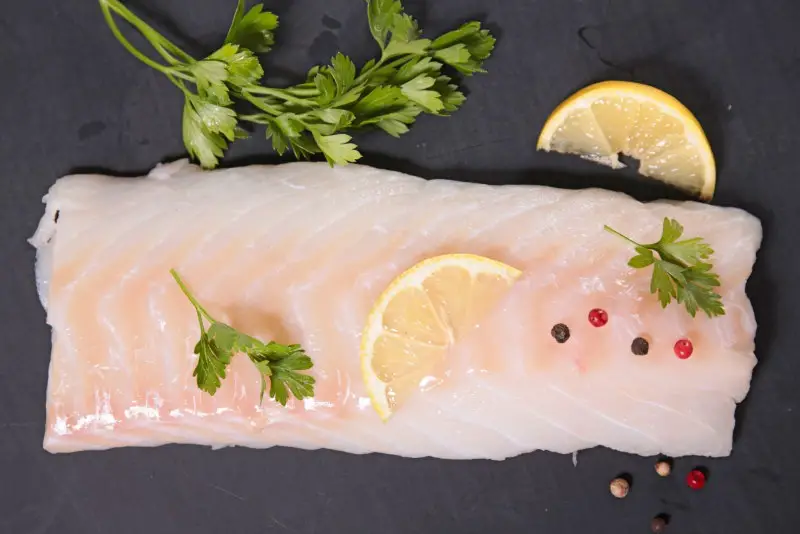Walleye is a freshwater fish that’s popular for sport fishing and as a food commodity. It’s part of the perch family and is commonly found in Canada and throughout the United States. It’s not the prettiest fish with its toothy mouth and clouded eyes, but are they good to eat?
Walleye is good to eat. It’s a mild-tasting white fish that’s similar to flounder. It’s also good for your health; it’s high in Omega-3 fatty acids along with other vitamins and minerals. Additionally, a walleye is a good option for people who dislike a strong “fishy” taste.
This article will discuss all these topics about walleye in more detail, including information about its flavor profile, what the meat is like, and some tips for preparing and cooking this fish.
What Does Walleye Taste Like?
Walleye is a flaky, white fish with a mild flavor. The taste is more subtle than some other fish, like salmon or tuna, with a slightly sweet flavor. It’s more comparable to yellow perch, flounder, grouper, or snapper.
However, since it’s a freshwater fish, walleye may have a slightly different taste than fish sourced from the sea.
Walleye has a firm texture, but it’s still moist and buttery. It’s not mushy like some other fish. But it’s also slightly more delicate than some white fish with larger flakes, like northern pike or halibut.
On its own, walleye can be pretty bland for some people’s taste buds. While that might sound like a bad thing about taste, it’s actually a plus since most people don’t eat fish totally plain. The mild flavor makes it a really versatile fish that you can season however you’d like and serve it with any side item.
Many people that believe they don’t like fish will find that they do enjoy walleye. These whitefish have a light taste that it’s palatable for those who don’t care for “fishy” flavors.
People who enjoy heavy seasonings or spicy foods will prepare walleye to be as exciting as they wish, while those with more tame taste buds can go with just a classic flavor.

Health Benefits of Walleye
Like other fish, walleye has many health benefits. Many leading health and medical organizations promote adding fish as part of a healthy diet. For example, the American Heart Association advocates eating fish at least twice per week to promote heart and circulatory health.
Research has shown that eating fish regularly (at least once per week) can lower the risk of heart disease by 15%.
Is Walleye Good For You?
Walleye, along with other fish, contains omega-3 fatty acids. Fish oils and omega-3s can reduce the risk for heart disease and stroke, improve joint health, lower inflammation around the body, and support brain health and functioning.
Fish like walleye are also rich in protein, calcium, and phosphorus. It’s also an excellent source of vitamin D and riboflavin. Vitamin D is an essential nutrient, and over 40% of Americans don’t get enough of it. Walleye and other fish are one of the best natural sources of vitamin D.
Walleye and Mercury
Most fish contain some amount of mercury, and walleye is no exception. Fish like walleye that eat other fish tend to have higher levels of mercury due to a process called biomagnification. Walleye tend to have even higher levels of mercury despite their smaller size, which is unusual but doesn’t mean that it’s dangerous to consume the fish.
The Minnesota Department of Health recommends that some populations (like pregnant women and children under 15) only eat walleye and other similar species once per month. In contrast, the general population can safely eat one serving per week.
What Is the Best Way To Clean and Cut Walleye?
The best way to clean a walleye is to cut it into two fillets and then remove the rib cage. Then, you can remove the skin and bones using a knife and your fingers. Wash the fillets in clean water and store them on ice until you’re ready to prepare them.
You’ll need a sharp fillet knife to clean your walleye. Walleye are not considered a large fish so a medium size fillet knife, like a 6″ should work well.
I really like this Meyer Wild Fish Fillet Set (available on Amazon) because it comes with different sizes of blades, a sharpener, and a cutting board altogether in a handy case. It’s highly versatile and can be used for more than just fish. It’s great for camping or grilling and can be used for other meats and vegetables.
Follow these steps to fillet a walleye:
- Place the fish on your cutting surface with the belly facing you and the fish head on your left. (If you are left-handed, reverse these instructions).
- Make a straight cut behind the fin down to the backbone but not cutting through it.
- Turn the knife and cut by sliding the knife toward the tail, holding firm pressure on the back of your blade. Cut through the rib cage and out through the tail.
- Flip the fish over and repeat the cutting process on the other side so that you have two fillets.
- Place one fillet skin-side-up with the ribcage down. Place your knife just above the rib cage and press down on the fish to flatten out the ribs. Cut toward the belly, allowing the blade to follow above the rib cage.
- Repeat this process for the second fillet.
- Remove the skin (if you wish) by simply cutting into the fish fillet at an angle until you reach the skin. Then, slide the knife between the skin and meat while keeping the blade at a slight angle. Use your free hand to pull the skin away from the knife in the opposite direction.
For a video tutorial on how to clean and fillet a Walleye, check out this video on YouTube:
How To Prepare Walleye
Walleye is a highly versatile fish that you can prepare in many different ways. Since the flavor is so mild, it can be seasoned and cooked however you like. It’s a quick-cooking fish, and it can be fried, broiled, grilled, or baked.
One of the most popular methods involves seasoning the fillets with your spices of choice, lightly flouring them, and then frying them in a shallow pan.
To cook walleye on a grill, you can lightly coat them with some olive oil or melted butter and grill them for two minutes on each side. Season with salt and pepper, along with whatever seasonings you like.
Walleye should be cooked to an internal temperature of at least 135°F (57°C) for food safety, but you should also be careful not to overcook it and dry it out.
Some people like to remove the skin before preparing their walleye, while others enjoy the fish’s skin. I’ve found that it’s easier to cook the fish with the skin intact and then remove it afterward, especially if you’re grilling it. Grilling fish with the skin on helps hold the fillet together and prevents sticking. Once the fish is cooked, you can peel the skin off with your fingers very easily.
Final Thoughts
Walleye is a freshwater white fish that’s very common throughout North America. It’s extremely versatile because of its mild flavor and firm but flaky texture. Many restaurants and individuals seek out walleye to serve their guests and families.
Like other fish, walleye is a healthy source of protein. People who like mild-flavored fish enjoy walleye because they can season it however they want and cook it in many different ways. All this, combined with the fact that they’re easy to catch, has made walleye one of the most popular fish in the Northern U.S. and Canada.





